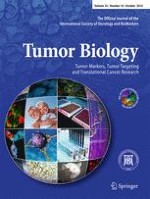Published in:

01-10-2014 | Research Article
Prognostic significance of the ratio of absolute neutrophil to lymphocyte counts for breast cancer patients with ER/PR-positivity and HER2-negativity in neoadjuvant setting
Authors:
Young Wha Koh, Hee Jin Lee, Jin-Hee Ahn, Jong Won Lee, Gyungyub Gong
Published in:
Tumor Biology
|
Issue 10/2014
Login to get access
Abstract
The aim of this study was to determine the predictive or prognostic impact of absolute neutrophil count/absolute lymphocyte count ratio (NLR) in breast cancer patients with estrogen receptor/progesterone receptor (ER/PR)-positive and human epidermal growth factor receptor 2 (HER2)-negative subtype who have received neoadjuvant chemotherapy (NAC). We performed retrospective analysis of 157 patients with primary breast cancer with ER/PR-positive and HER2-negative subtype who were treated with NAC, followed by definitive surgical resection. The median follow-up after surgery was 21 months (range, 1–108 months). On univariate analysis, high NLR (>2.25) correlated with poorer recurrence-free survival (RFS) and overall survival (OS) (P = 0.001 and P < 0.001). Subgroup analysis of non-pathologic complete response (pCR) subgroup showed that high NLR was significant for RFS and OS (P = 0.001 and P < 0.001). Particularly, high NLR patients had inferior clinical outcomes in the high clinical stage. Uni- and multivariate Cox analysis showed NLR to be an only predictor of RFS and OS. The NLR is an independent prognostic factor for RFS and OS in breast cancer patients with ER/PR-positive and HER2-negative subtype receiving NAC. The NLR provides additional prognostic information to choose suitable patients who might profit from further therapy.





